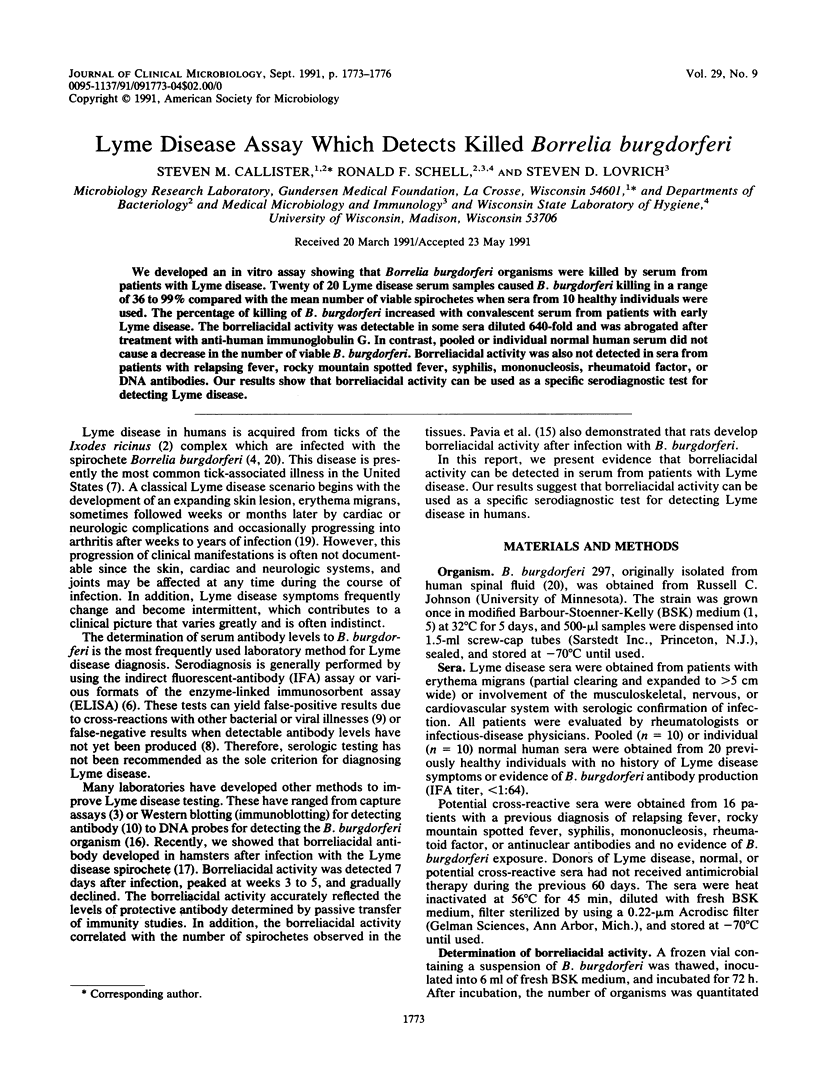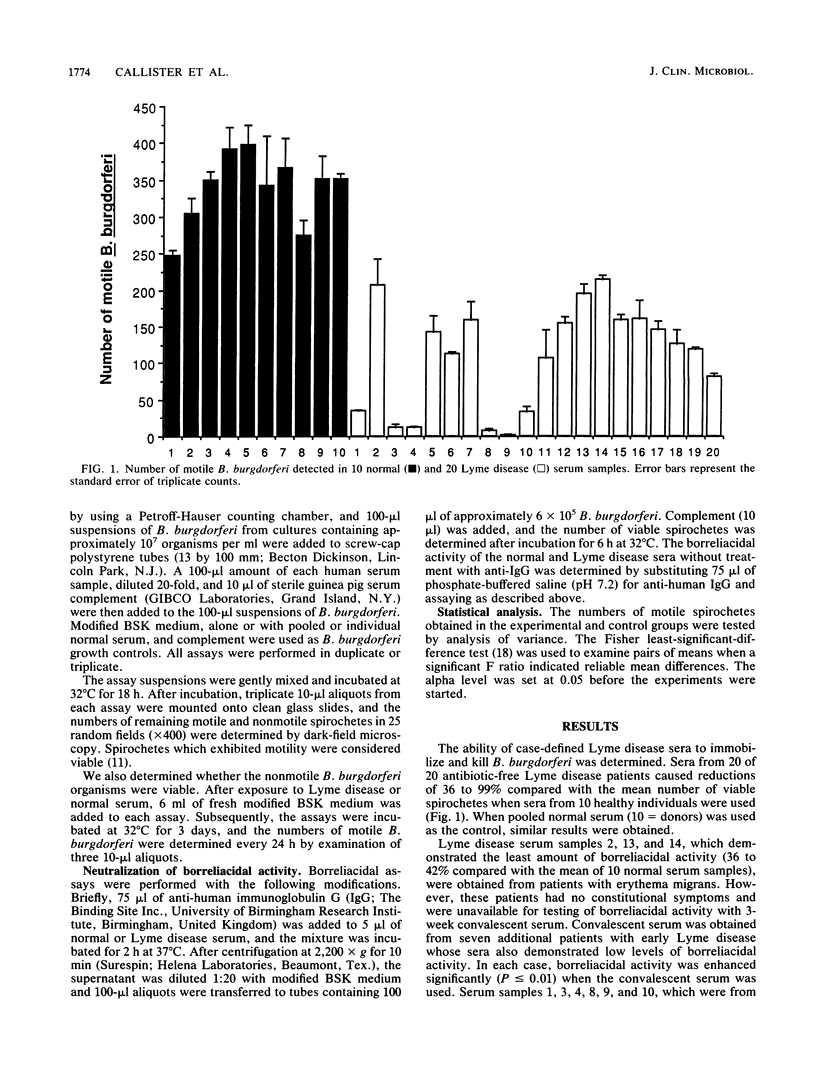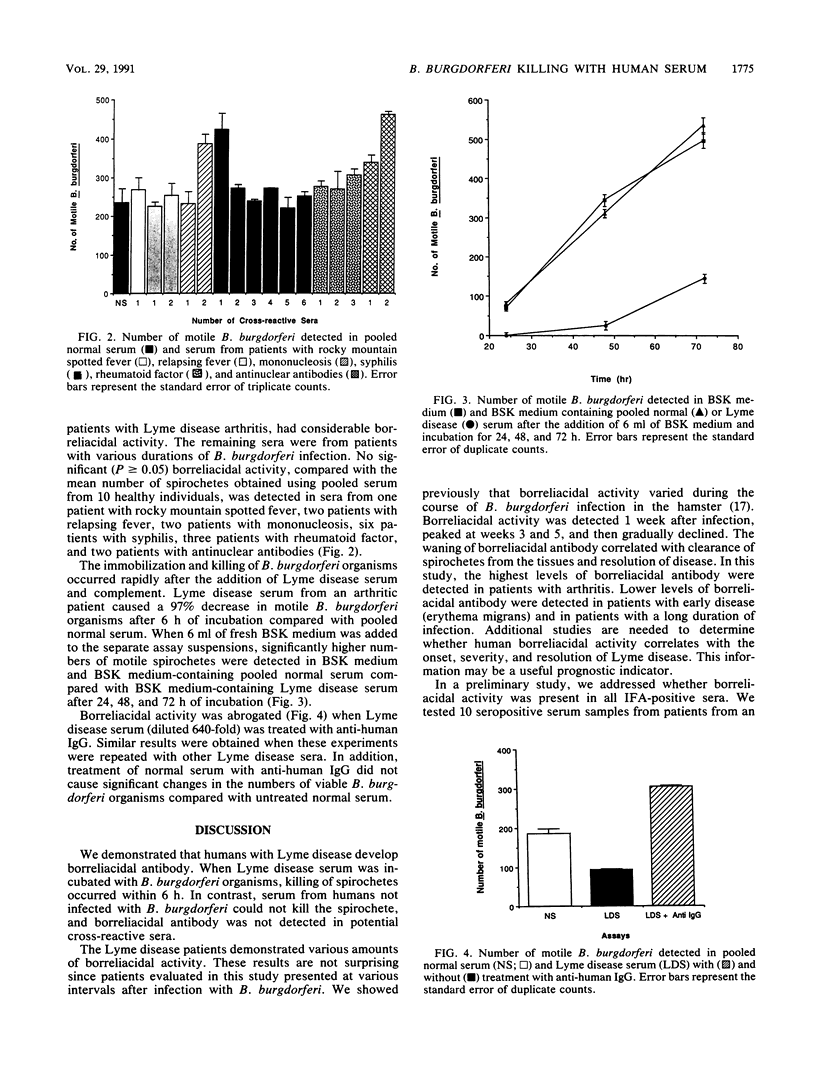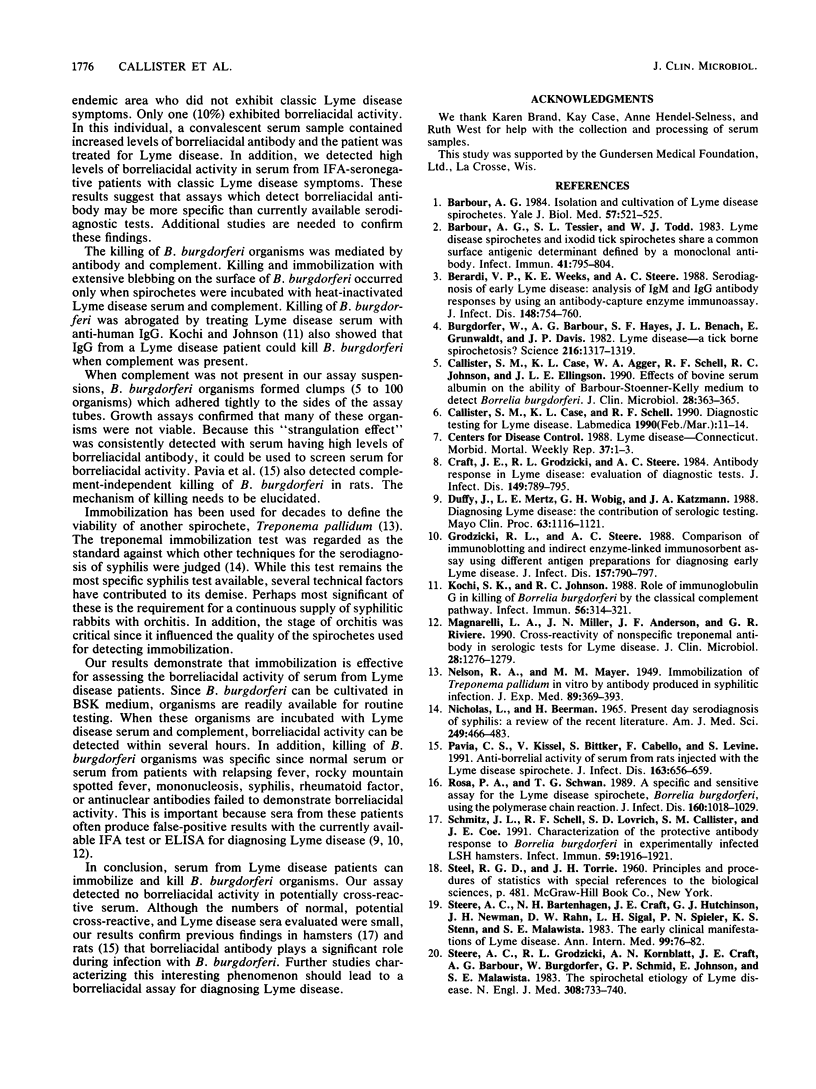Abstract
We developed an in vitro assay showing that Borrelia burgdorferi organisms were killed by serum from patients with Lyme disease. Twenty of 20 Lyme disease serum samples caused B. burgdorferi killing in a range of 36 to 99% compared with the mean number of viable spirochetes when sera from 10 healthy individuals were used. The percentage of killing of B. burgdorferi increased with convalescent serum from patients with early Lyme disease. The borreliacidal activity was detectable in some sera diluted 640-fold and was abrogated after treatment with anti-human immunoglobulin G. In contrast, pooled or individual normal human serum did not cause a decrease in the number of viable B. burgdorferi. Borreliacidal activity was also not detected in sera from patients with relapsing fever, rocky mountain spotted fever, syphilis, mononucleosis, rheumatoid factor, or DNA antibodies. Our results show that borreliacidal activity can be used as a specific serodiagnostic test for detecting Lyme disease.
Full text
PDF



Selected References
These references are in PubMed. This may not be the complete list of references from this article.
- Barbour A. G. Isolation and cultivation of Lyme disease spirochetes. Yale J Biol Med. 1984 Jul-Aug;57(4):521–525. [PMC free article] [PubMed] [Google Scholar]
- Barbour A. G., Tessier S. L., Todd W. J. Lyme disease spirochetes and ixodid tick spirochetes share a common surface antigenic determinant defined by a monoclonal antibody. Infect Immun. 1983 Aug;41(2):795–804. doi: 10.1128/iai.41.2.795-804.1983. [DOI] [PMC free article] [PubMed] [Google Scholar]
- Berardi V. P., Weeks K. E., Steere A. C. Serodiagnosis of early Lyme disease: analysis of IgM and IgG antibody responses by using an antibody-capture enzyme immunoassay. J Infect Dis. 1988 Oct;158(4):754–760. doi: 10.1093/infdis/158.4.754. [DOI] [PubMed] [Google Scholar]
- Burgdorfer W., Barbour A. G., Hayes S. F., Benach J. L., Grunwaldt E., Davis J. P. Lyme disease-a tick-borne spirochetosis? Science. 1982 Jun 18;216(4552):1317–1319. doi: 10.1126/science.7043737. [DOI] [PubMed] [Google Scholar]
- Callister S. M., Case K. L., Agger W. A., Schell R. F., Johnson R. C., Ellingson J. L. Effects of bovine serum albumin on the ability of Barbour-Stoenner-Kelly medium to detect Borrelia burgdorferi. J Clin Microbiol. 1990 Feb;28(2):363–365. doi: 10.1128/jcm.28.2.363-365.1990. [DOI] [PMC free article] [PubMed] [Google Scholar]
- Craft J. E., Grodzicki R. L., Steere A. C. Antibody response in Lyme disease: evaluation of diagnostic tests. J Infect Dis. 1984 May;149(5):789–795. doi: 10.1093/infdis/149.5.789. [DOI] [PubMed] [Google Scholar]
- Duffy J., Mertz L. E., Wobig G. H., Katzmann J. A. Diagnosing Lyme disease: the contribution of serologic testing. Mayo Clin Proc. 1988 Nov;63(11):1116–1121. doi: 10.1016/s0025-6196(12)65506-2. [DOI] [PubMed] [Google Scholar]
- Grodzicki R. L., Steere A. C. Comparison of immunoblotting and indirect enzyme-linked immunosorbent assay using different antigen preparations for diagnosing early Lyme disease. J Infect Dis. 1988 Apr;157(4):790–797. doi: 10.1093/infdis/157.4.790. [DOI] [PubMed] [Google Scholar]
- Kochi S. K., Johnson R. C. Role of immunoglobulin G in killing of Borrelia burgdorferi by the classical complement pathway. Infect Immun. 1988 Feb;56(2):314–321. doi: 10.1128/iai.56.2.314-321.1988. [DOI] [PMC free article] [PubMed] [Google Scholar]
- Magnarelli L. A., Miller J. N., Anderson J. F., Riviere G. R. Cross-reactivity of nonspecific treponemal antibody in serologic tests for Lyme disease. J Clin Microbiol. 1990 Jun;28(6):1276–1279. doi: 10.1128/jcm.28.6.1276-1279.1990. [DOI] [PMC free article] [PubMed] [Google Scholar]
- NICHOLAS L., BEERMAN H. PRESENT DAY SERODIAGNOSIS OF SYPHILIS. A REVIEW OF SOME OF THE RECENT LITERATURE. Am J Med Sci. 1965 Apr;249:466–483. doi: 10.1097/00000441-196504000-00016. [DOI] [PubMed] [Google Scholar]
- Pavia C. S., Kissel V., Bittker S., Cabello F., Levine S. Antiborrelial activity of serum from rats injected with the Lyme disease spirochete. J Infect Dis. 1991 Mar;163(3):656–659. doi: 10.1093/infdis/163.3.656. [DOI] [PubMed] [Google Scholar]
- Rosa P. A., Schwan T. G. A specific and sensitive assay for the Lyme disease spirochete Borrelia burgdorferi using the polymerase chain reaction. J Infect Dis. 1989 Dec;160(6):1018–1029. doi: 10.1093/infdis/160.6.1018. [DOI] [PubMed] [Google Scholar]
- Schmitz J. L., Schell R. F., Lovrich S. D., Callister S. M., Coe J. E. Characterization of the protective antibody response to Borrelia burgdorferi in experimentally infected LSH hamsters. Infect Immun. 1991 Jun;59(6):1916–1921. doi: 10.1128/iai.59.6.1916-1921.1991. [DOI] [PMC free article] [PubMed] [Google Scholar]
- Steere A. C., Bartenhagen N. H., Craft J. E., Hutchinson G. J., Newman J. H., Rahn D. W., Sigal L. H., Spieler P. N., Stenn K. S., Malawista S. E. The early clinical manifestations of Lyme disease. Ann Intern Med. 1983 Jul;99(1):76–82. doi: 10.7326/0003-4819-99-1-76. [DOI] [PubMed] [Google Scholar]
- Steere A. C., Grodzicki R. L., Kornblatt A. N., Craft J. E., Barbour A. G., Burgdorfer W., Schmid G. P., Johnson E., Malawista S. E. The spirochetal etiology of Lyme disease. N Engl J Med. 1983 Mar 31;308(13):733–740. doi: 10.1056/NEJM198303313081301. [DOI] [PubMed] [Google Scholar]


